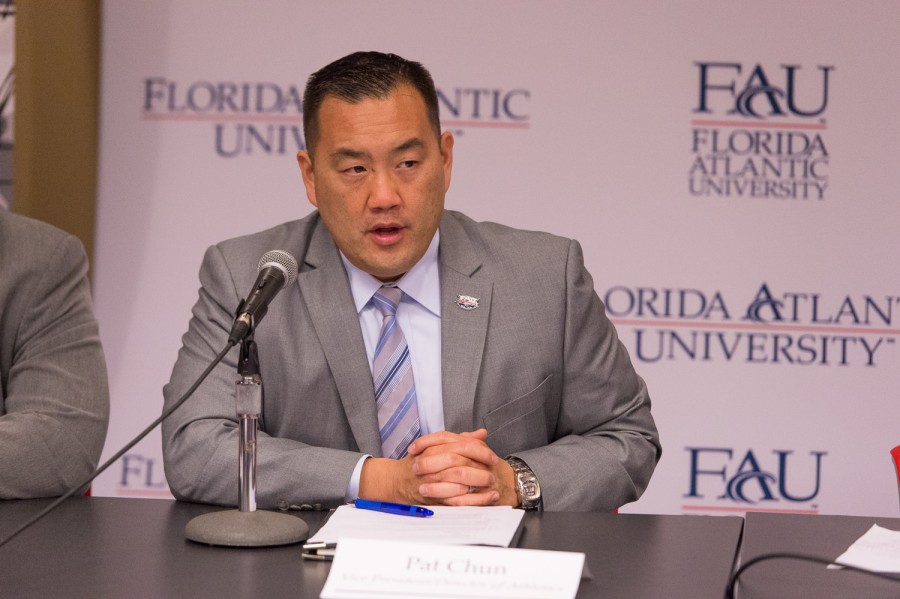Column: O’Bannon verdict and Owls Athletes
A year after the Ed O’Bannon decision, athletes on way to receiving compensation for the use of their likeness for first time ever.
Pat Chun’s proposed cost of attendance stipend is first step toward athletes being paid for the use of their likeness. Photo by Max Jackson.
August 10, 2015
$989 million.
That total dollar amount represents the amount of revenue that the National Collegiate Athletic Association (NCAA) raised in its most recent fiscal year, primarily from selling merchandise and television rights for their sporting events and competition.
That’s enough earnings to place it below big four professional sports leagues (NFL, MLB, NBA and NHL) and above Major League Soccer in terms of league-earned revenue.
There’s only one problem: The NCAA doesn’t compensate its athletes a single cent in cash for their participation. As a not-for-profit (I’m laughing with you on that one) organization, they offer their workers an education through their universities.
I find it hard to believe that serves as full compensation for the job most Division I athletes do. The most obvious fact is that most athletes do not receive the best education while away from the classroom for much of a semester.
Adding on to that, graduation rates have not always been high for athletes, especially for FAU.
The system currently in place does not give athletes as much incentive to strive in their studies, as much as force the issue that winning on the field trumps all.
Even with scholarships, the system itself doesn’t compensate equally.
With a limited amount of athletics scholarships – schools are limited to 240 total across all sports, but can be split among multiple individuals – many student-athletes are left to scrap for combined packages that might not address their needs completely or leave them without anything at all.
There are changes on the way. Former NCAA athletes Ed O’Bannon (UCLA) and Sam Keller (Arizona State) have filed class-action lawsuits on behalf of current and past players accusing the association of using their likenesses without permission or proper compensation.
The O’Bannon lawsuit won the ability for players in the power five conference conferences to receive no less than $5,000 a year from their respective institutions. Players would be eligible if on an athletic scholarship at their college or university.
The respective money would be put away in a trust and paid in full after a player exhausts his eligibility or graduates, and would not be mandatory until 2017.
NCAA rules are not forcing schools to give athletes the stipend yet, but those institutions that do not may be at a perceived competitive disadvantage in recruiting new players if they do not offer money.
Even without the money though, players are still going to go to the bigger school a majority of the time.
Economist Andy Schwarz found that players tended to wind up where they were most valued, noting that in the 2000s, 99.3 percent of the top 1,000 athletes in football went to schools in the power five conferences.
Reminder: this is even before money comes into play.
The Keller case was settled out of court last June, and the plaintiffs will receive $20 million, but not from the NCAA. The money comes from Electronic Arts and The Collegiate Licensing Company, and only for players who previously played during the years the games with their likenesses were produced.
End of story, right?
Wrong.
The NCAA won a stay on the O’Bannon payments in court, which were supposed to be allowed on the first of this month after being approved a year ago.The stay means that the schools do not have to pay their athletes, serving as a delay so the Association can potentially appeal the decision.
Every second the case is put on hold could mean a reversed decision, putting an end to all the progress.
The eventual settlement in the O’Bannon case does bring an interesting question: What will be the fate of mid-major schools like FAU? The athletic department has a stringent budget as it is. Can it survive another expense?
In an interview with FAUOwlAccess in January of this year, Florida Atlantic Athletic Director Patrick Chun has proposed a $4,650 maximum cost of living stipend for all athletes on scholarships.
Chun proposed the stipend about six months after the O’Bannon case decision, and is not subject to the $ 5,000 dollar limit because the program is in a smaller conference.
Paid on a yearly basis, the stipend would be used to cover costs not covered by a scholarship, a welcome change from the current situation. It would mirror the Power Five conferences in money offered, and not affect eligibility because it would be given as financial aid.
But where the money would come from is a deciding factor of whether this all will go smoothly.
FAU Athletics receives much of their revenue from subsidies provided by the school itself. The program would probably not exist the way it currently does without the subsidies, especially because of the small amount of revenue its sports create, and the fact that most sports lose money.
For all of the scholarships the athletic program offers, the Owls would require $930 thousand to pay the stipends for 200 student athletes. Such a total is a large undertaking for the school, but not a cripplingly impossible goal to reach.
FAU earned $2.1 million in media earnings during the last fiscal year, mostly from television and radio rights to their athletic events.
I say that would be the best place to take money for the stipend. It only makes sense to give the money to the athletes who create said revenue for the school.
Forgotten in all of this are walk-ons, many of which receive academic financial aid available to all students instead of athletic scholarships. Even with that, they are still ineligible to receive the funds available to those on athletic scholarships.
The reality colleges face in the changing landscape is very real and likely to progress through the courts quickly. While we won’t see athletes bargaining for million dollar salaries, treatment of the player’s rights to the money needs to be addressed now, by allowing the players to have the right to decide of what their likeness is used for.
There’s no denying the NCAA is broken in some regards, with an archaic set of rules creating some very laughable and some tragic rules violations. For example, some basketball rule-breaking compiled here by The Sporting News ranges from outrageously unfair to comedic gold.
Sad thing is, the Association doesn’t give the very people who are under their umbrella a louder voice at the table. The programs and the conferences decide what’s right, not the very people that create profit and put their bodies on the line.
Until the athletes can unionize or receive a forum from which they can voice their opinions (don’t hold your breath), the athletes face an uphill battle to make changes.

Ryan Lynch is the sports editor for the University Press. For tips regarding this or other articles, he can be reached at ryanmlynch77@gmail.com or on twitter (@RyanLynchwriter).







